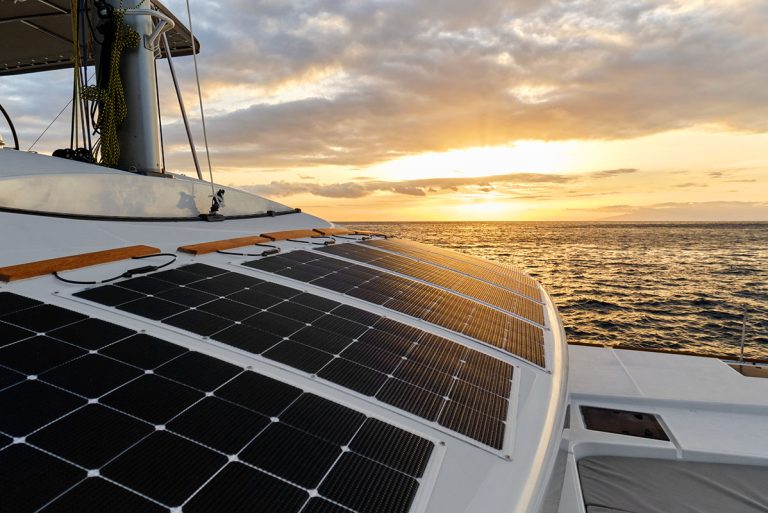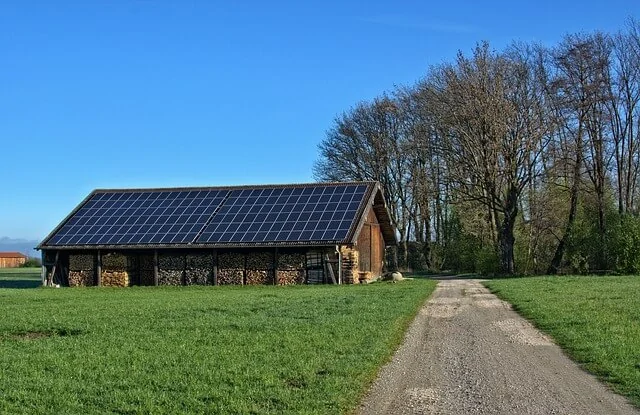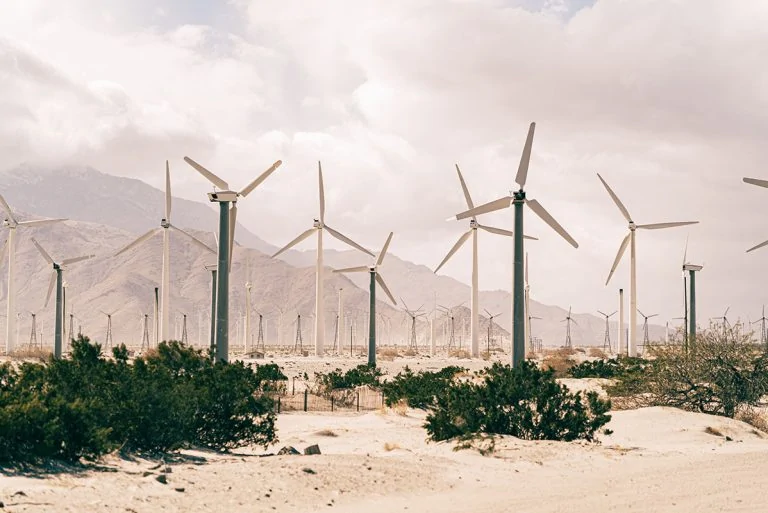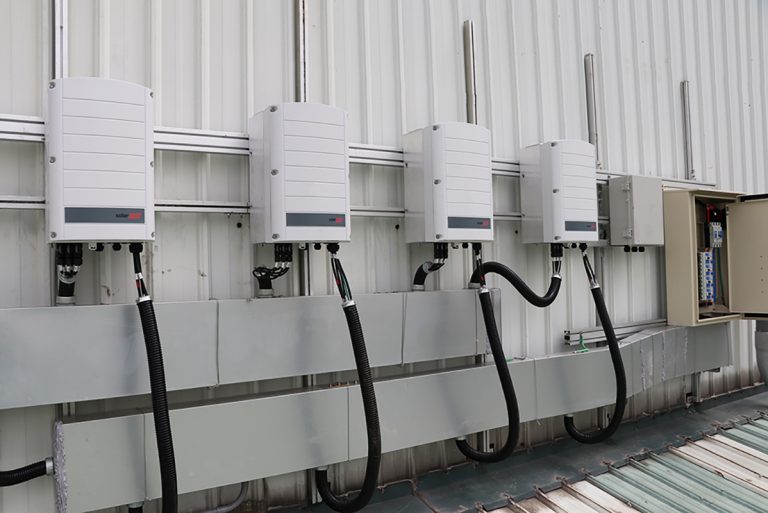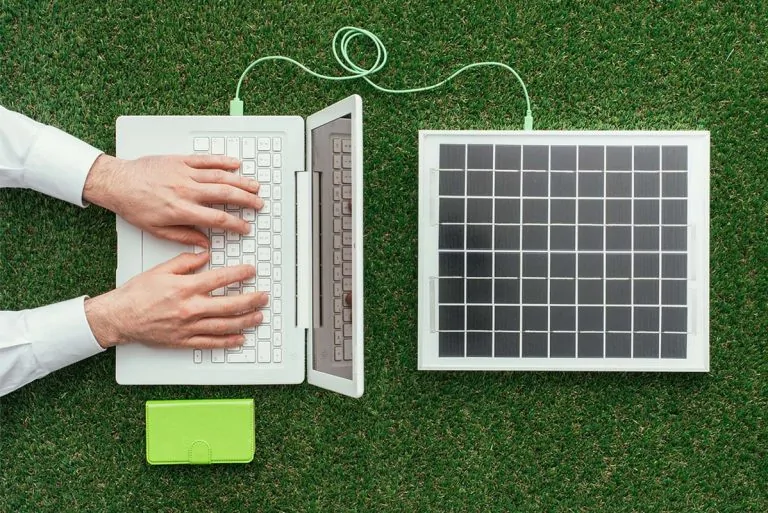Flexible solar panels are ideal for RVs, boats, or for mounting on curved roofs. They also make a great alternative to diesel-powered generators for a sustainable and portable source of energy.
However, these kinds of panels also have their limitations, so it’s important to know the pros and cons in order to choose the right type of panel for your needs.
Our favorite flexible solar panels
These are our top picks for the most efficient, durable, and high-quality flexible solar panels available today.
1. Renogy 100 Watt 12 Volt Flexible Monocrystalline Solar Panel
This flexible solar panel from Renogy weighs just over four pounds, so is not only portable, but also suitable for roofs which cannot bear much weight. It’s also highly flexible: you can bend it up to 248 degrees, meaning you’ll be able to install it on very curved surfaces.
The durable panel will stand up to all kinds of weather conditions, including strong winds and snow. With three different watt sizes to choose from, you’ll be able to select the product to meet your needs.
Key features and benefits:
- 5-year product/25-year power warranty
- Lightweight, weighing just 4.2 lbs
- Flexible up to 248 degrees
- Tested for resistance up to winds up to 2400 Pa and snow loads up to 5400 Pa
- Also available in 50 watt and 175 watt sizes
2. ALLPOWERS Portable Power Station with 60W Foldable Solar Panel
This portable power station kit comes with not only a flexible solar panel, but also a portable solar generator and an AC wall charger adapter. It’s a complete, mini solar system that you can use to charge your laptop, car battery, phone, or other devices when enjoying outdoor activities or during an emergency.
The high-efficiency, 60-watt solar panel can be folded for easy transport and is compatible with most solar generators. The light-weight power station comes with five 2.4A USB ports and one 18V DC port that you can use to charge your laptop or 12V car battery.
Key features and benefits:
- Kit includes 60-watt foldable solar panel, 154Wh portable generator, and charger adapter
- High conversion efficiency monocrystalline solar panel, up to 23% more efficient than other flexible solar panels
- Solar panel is compatible with most solar generators
- Complete kit for RV, camping, boating, or outdoor activities
- Includes voltage regulator – no converter needed to charge smartphones, laptops, power banks, or a 12V car battery
3. UniSolar Peel & Stick Amorphous 24V Solar Panel 136 Watts
This flexible solar panel features a peel-and-stick design which makes it easy to install with no additional equipment needed. It is portable, making it ideal for camping and offroading, while being highly durable.
You can install this versatile solar panel virtually anywhere, including on metal roofs, without worrying about damage from exposure to high temperatures. Unlike many flexible solar panels, this one comes with a reassuring 20-year warranty.
Key features and benefits:
- 20-year power warranty
- Peel and stick backing that will adhere to most surfaces without needing any additional mounting equipment
- Highly durable and shatter-resistant
- Portable: can be rolled up into a 16-inch box for transport
- Designed to withstand high temperatures, including on metal roofs
4. Genssi 4X 100W Flexible Solar Panel Kit
This flexible solar panel boasts a PV cell density of 22% more than some comparable products, making it highly efficient, meaning you can generate more power for the same surface area. The durable, long-lasting product features TPT black sheets and has been tested to be free from hot-spot heating to avoid the risk of damage to the panel.
This panel works well in low light, so you’ll enjoy a decent power supply even on cloudy days or in the late afternoon. Although the product warranty only applies for five years, this panel comes with a 25-year warranty for its power systems.
Key features and benefits:
- Ultra-efficient mono crystalline design that packs up to 22% more PV cells into the same area
- 5-year product/25-year power warranty
- Tested to be free from hot-spot heating
- TPT black sheets for longer life
- Performs well in low light conditions
What are flexible solar panels?
Flexible solar panels are exactly as they sound – they’re essentially the same as rigid solar panels but in a malleable, bendable (i.e. ‘flexible’) form. They’re typically thinner than regular solar panels, usually three to five mm thick, and made of one or more layers of thin photovoltaic film with a plastic backing.
It used to be that flexible solar panels were not as effective as their traditional counterparts. However, technology has come a long way, and more flexible panels these days work just as well as rigid ones.

Being lightweight and flexible makes these panels highly portable and ideal for mounting on curved or uneven surfaces. You most often see these kinds of panels on RVs or boats, but they can also be used on curved roofs and awnings, or on any structure that can’t take the weight of a regular solar panel.
Because they use less material, flexible solar panels are also generally cheaper.
However, it’s important to note that three is a limit to this flexibility – you can usually curve these panels at up to a 30º radius. Any more will likely break the PV cells, rendering the panel useless.
Different types of flexible solar panels
Flexible solar panels can be made from a range of materials, and their level of flexibility, and therefore how far you can bend them will depend on the material the panels are made from.
Common types of flexible solar panels are:
- CIGS, or copper indium gallium selenide solar panels
- Amorphous silicon solar panels
CIGS panels have limited flexibility, but are generally suitable for mounting on an RV, boat, or curved building surface. They may also come with an aluminum frame that further limits their flexibility.
On the other hand, amorphous silicon solar panels are highly flexible: some can be wrapped around a cylinder with a 5 cm diameter without damage.
Are flexible solar panels suitable for your home?
Although flexible solar panels are most commonly used on RVs or boats, there are certain circumstances where they may also be a good choice for your home.
Generally, if your house’s roof is made up of broad, flat, and rectangular surfaces (like most home roofs) rigid solar panels are probably the best choice for you. Traditional solar panels are durable, highly efficient, and capable of withstanding extreme weather and temperatures.

However, if your roof is curved, arched, or not able to take the weight of rigid solar panels, traditional panels won’t be suitable. They’ll also be a no-go if you don’t want to compromise the structure or shape of your roof with the hardware necessary to mount these kinds of panels.
In this case, flexible solar panels can be a viable alternative, though you’ll need to weigh up the pros and cons, which we’ll cover later in this article. In most cases, rigid solar panels are your best choice for home use.
How to mount flexible solar panels
Flexible solar panels are much easier to install than conventional ones, and this is something you can usually do yourself, even if you have limited technical expertise or experience.
You have a few different options when it comes to flexible solar panel installation, with the most common being using adhesive or a mounting rack.
Using a mounting rack
Some flexible solar panels come in a kit which includes a mounting rack. If this is the case, simply follow the manufacturer’s instructions to assemble the mount, attach it to your boat, RV, or roof, and then connect the panel.
Using an adhesive
Some products, like the UniSolar Peel & Stick Amorphous Solar Panel, come with an inbuilt adhesive backing that makes it easy to simply stick to the surface where you want to mount your panel.
You can glue virtually any flexible solar panel onto most surfaces, but this could lead to a couple of issues if not done properly. Firstly, the panel won’t be able to expand as it heats up in the sun, and so may crack or sustain other damage.
Additionally, gluing the panel directly onto a roof or other surface may cause it to overheat.
To avoid these issues, follow these steps:
- Take two thin aluminum sheets (around 3mm thickness is ideal) and one polyethylene sheet and cut them down to the same dimensions as your flexible solar panel.
- Glue the three sheets together with marine grade adhesive, forming a polyethylene sandwich between the aluminum.
- Glue the flexible solar panel onto your sandwich with the same adhesive, and then attach it to a twin-wall polycarbonate bracket. Leave a 8mm gap between the sandwich and polycarbonate components for air flow.
- Attach the unit to your RV, boat, or wherever you want to install the panel with polycarbonate-friendly adhesive.
This combination of aluminum, polyethylene, and polycarbonate helps to protect the panel from overheating, as well as avoiding damage by allowing the various materials to contract and expand as the temperature changes.
Tips for installing flexible solar panels
Although flexible solar panels are relatively-easy to install, there are a few things you should keep in mind to avoid damage and set your panels up for a long, productive life.
Allow your panels to expand and contract
All materials expand when exposed to heat and contract as they cool, and each type of materials expands and contracts at a different rate. Therefore, if you attach your solar panel to a different kind of material, it could easily crack or buckle as the various materials expand differently.
That’s why it’s important to accommodate this expansion and contraction by installing your panel on a suitable mounting bracket, or a sandwich like the one described above.
Never over-extend flexible solar panels
Flexible solar panels are designed to bend and flex, but within certain limits. It’s important to avoid over-bending these panels during installation, and ensure that they’re not under any strain.
Aim for gentle curves rather than attempting to bend, fold, or wrap the panel. Always check the product’s specifications and never curve it beyond the degree they’re rated for.
This is essential, because curving the panel beyond this point could not only break or bend it, but also void your warranty.
Ventilation
Ventilation is another important factor to keep in mind. Solar panels, particularly flexible ones, are prone to overheating – this is not surprising given they sit all day in direct sunlight, often on top of reflective surfaces such as metal roofs.
Overheating could make the solar panel less efficient, shorten its working life, or even cause damage. Therefore, it’s important to allow for adequate ventilation, such as having a space between the panel and the surface it’s attached to, in order to keep the panel cool.
Pros of flexible solar panels
Flexible solar panels have their drawbacks, but they also come with a number of advantages. Let’s start by looking at the benefits before moving on to the disadvantages.
They’re flexible and lightweight
One of the key advantages of flexible solar panels is that they’re highly flexible and lightweight. Because of this, they’re suitable for places where you can’t install rigid solar panels, such as on your boat, RV, or a curved roof or awning.
If you want to install a solar panel somewhere that can’t take the weight of a rigid solar panel, a flexible solar panel is your best bet. They’re also useful for small or curved surfaces where you can’t or don’t want to install a supporting structure for a traditional solar panel.
You can take them anywhere
This characteristic also makes them highly portable. Some flexible solar panels can even be folded down to the same size as a sleeping bag or out in a backpack.
You can use flexible solar panels as a convenient and sustainable power source while camping, off-roading, trekking, or sailing. You’ll be able to charge your electronics anywhere, as long as there’s sunlight.

Source: Flickr / Michaela Pereckas
Additionally, if you decide to move house or remodel, it’s much easier to move and reinstall flexible solar panels.
See this article for more portable solar panel options.
They’re a better, more sustainable alternative to diesel generators
Flexible panels also make a great substitute for portable diesel generators for camping, other outdoor activities, or in case of power outages.
Flexible solar panels have a number of advantages over diesel generators: they’re silent, low-maintenance, and you don’t need to worry about stocking up or transporting fuel – all you need is the sun! Best of all, they work on clean, sustainable energy rather than fossil fuels which generate pollution and greenhouse gas emissions.
Better performance in cloudy weather
Flexible solar panels can get a bad rap performance wise, but this technology has come a long way in recent years. These days, good-quality flexible panels work just as well as conventional ones.
In fact, flexible solar panels actually perform better on cloudy days, as the thin-film material can absorb a wider spectrum of sunlight. Learn more in our guide to solar panels performance in different weather conditions.
They also perform better at high temperatures
All solar panels become less efficient at high temperatures, but thin-film solar panels suffer less of a performance drop under these conditions. Flexible solar panels are around 8% less efficient under high temperatures, compared to a 25% drop in efficiency for rigid panels.
They’re easy to install
Generally speaking, flexible solar panels are easier to install than their rigid counterparts. In many cases, you can install them yourself even if you have limited technical knowledge, so you’ll save on installation costs.
Cons of flexible solar panels
Despite the benefits, flexible solar panels also come with a number of disadvantages and limiting factors. This means that although they can be useful in some circumstances, they’re not the best choice for some situations.
They’re not as efficient as rigid solar panels
Although this depends on the model, most flexible solar panels are less efficient than their rigid counterparts. Efficiency is important, because it determines how much energy your panel will generate from the available sunlight.
This means that you’ll have less power to run your appliances and devices, or will need more panels (and more space) to produce the same amount of power.
Most thin-film panels have an efficiency of around 13% and as low as 7%, compared to 20 to 25% efficiency in the majority of rigid panels. However, some high-quality flexible monocrystalline panels claim up to 25% efficiency, so it does depend on the product you choose and how much you’re willing to spend.

Source: Wikimedia / Asurnipal
They’re also not as powerful
The power output of both rigid and flexible solar panels varies depending on the panel. However, generally speaking, most flexible solar panels are not as powerful as rigid ones.
You’ll struggle to find a flexible solar panel with more than around 150 watts of power output, while 250 to 300-watt rigid panels are fairly standard. Although a 100 to 150-watt panel is suitable for most RV or boating needs, they’re not really suitable to power an entire household solar system.
They’re not as durable or long-lasting
Again, this varies depending on the individual product, but rigid solar panels are generally much more durable and resistant to harsh weather conditions than flexible panels. While rigid panels are covered in robust glass, their flexible counterparts are coated in more fragile plastic.
Typically, rigid solar panels will last up to 25 years, while flexible ones are rarely designed to last between two and five years, which is reflected in much shorter manufacturers’ warranties.
What to consider when buying flexible solar panels
There’s now a wide range of flexible solar panels available, which is great news for anyone looking for a flexible, portable, and lightweight source of solar energy. However, it can also be a bit overwhelming to work out which is the best product for you.
Here are a few key factors to keep in mind when shopping for flexible solar panels.
Power output and efficiency
Power output is a critical factor when buying solar panels of any kind.
This doesn’t necessarily mean that you need a panel with the highest possible power output, if you don’t require that amount of power. Rather, it’s about calculating your power requirements and making sure that the panel will produce enough power to meet your needs.
For more, take a look at this guide to solar panel size.
Equally, efficiency is important. The less efficient the solar panel is, the more space it will take up to deliver the same amount of energy.
Generally speaking, you should look for a minimum efficiency of around 11-13% when buying flexible panels.
Weight and size
The size and weight of the panel is another essential factor to consider. Be sure to consider where you’re planning to install your panel and ensure that the panel you choose fits the space, and that the surface can support its weight.

Source: Flickr / RVWithTito.com
You should also consider the curve of the surface where you want to install your solar panel. Different products are rated to various degrees of flexibility, to check this before making a final purchasing decision.
Durability
It’s important to make sure the panel you choose will be able to withstand weather and other conditions it will be exposed to. As a first step, look at the materials the panel is made from.
Look for flexible solar panels that are made from ethylene tetrafluoroethylene, as this material is more durable than polyethylene terephthalate, which is commonly used to make these kinds of panels.
If you’re buying a solar panel for a boat, make sure that it’s well sealed, which is measured by its ingress protection rating. For marine use, you should look for a panel with a minimum ingress protection rating of 67.
Accessories
Be sure to check which accessories come with your panel. Most flexible solar panels come with power connections, and some may also come with assembly tools and/or adhesive.
Also consider whether the panel comes with a mounting bracket or similar, if this is how you want to install your panel.
Warranty
Warranty is another essential factor. Not only does a longer warranty give you peace of mind, but it also implies how long the manufacturer expects their product to last, so it is an indication of quality.
For flexible solar panels, most manufacturers only offer a one or two-year warranty. However, some products, like the Renogy 100 Watt 12 Volt Flexible Monocrystalline Solar Panel and Genssi 4X 100W Flexible Solar Panel Kit come with a five-year warranty.
Flexible vs. rigid solar panels: Which is best?
The choice between flexible and rigid solar panels is not clear-cut: it depends on your preferences and what you want to use the panel for.
Since flexible solar panels are lightweight, they are ideal for anything that is designed to move, like RVs, boats and in some cases, cars. Their flexibility also makes them suitable for curved roofs and other surfaces where you may not be able to install a conventional panel.
On the other hand, rigid solar panels are more durable, efficient, and typically produce more power, so are generally better for home solar systems.
Want to learn more about solar panels? Check out our guides to what solar panels are made of, solar panel wiring, and solar panel trickle chargers.
